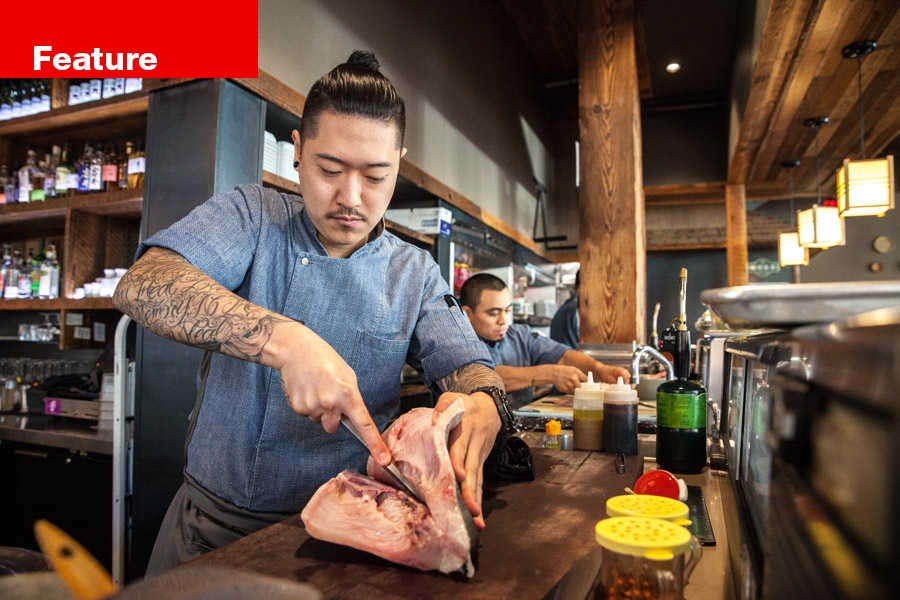Bamboo Sushi founder seeks to change the way people think about seafood.
From a terrace at the Japanese Garden framed by bonsai and maples, on the evening of August 23, the Portland elite gazed down on the city they run. Glasses of rosé in hand, Mayor Ted Wheeler mingled with Governor Kate Brown and Salt & Straw owner Kim Malek.
Kristofor Lofgren, CEO of the Portland-based Sustainable Restaurant Group, had convened the 20 or so politicians, real estate developers and restaurateurs. For him the party marked another small step on his quest to promote sustainable business practices.
At a table on the veranda, in front of the pavilion’s shoji, the iconic Japanese paper windows, guests paused for a toast from Lofgren. “There’s more people moving here every week,” he said in his characteristic tone, laid-back, straightforward and concise. “We want to guide the city’s growth and development in the right way.”

Kristofor Lofgren addresses dinner party guests,
including Portland mayor Ted Wheeler.
In today’s hyper-competitive restaurant market, sustainability makes for good business. Sustainable eating is one of the most notable, and profitable, shifts of the past several years. Eateries that align themselves with a cause attract talent, win investment and cement relationships with fickle consumers.
“People will eat more sushi five years from now than today, while there’s been declining sales in pizza, traditional fast food and grocery stores that didn’t get on the organic bandwagon early enough,” Lofgren says. “If people all want to do something, as a business, you need to be a part of that.”
Sustainable Restaurant Group is riding the wave. The company opened a Pearl District QuickFish this summer, bringing its total of casual poke bars to two in Portland, one in Denver. It plans to open a sixth Bamboo Sushi this summer in Lake Oswego. In April the company took a shot of outside investment from Bain Capital’s Double Impact Fund, geared toward companies that demonstrate social and environmental responsibility. The capital infusion hints at an impending expansion into new markets, most likely San Francisco and Seattle.
Yet risks lie ahead for sustainable eateries balancing on the industry’s tightrope margins. An economic boom and tight labor market have intensified competition for workers and customers. Lofgren must maintain his sustainability focus while scaling his business.
“In general what we’re seeing is a squeezing of mediocrity,” Lofgren says. “It’s actually harder in a booming economy like we have now. There’s a fight for talent. There’s a fight for the dollar.”
Changing the way people eat begins with a great deal of minutiae. On a Tuesday afternoon, Lofgren, dressed in a striped long-sleeve T-shirt and shorts and shaking a large salad, presides over the company’s weekly staff meeting. The third-floor corner office of the Morrison Street co-working space CENTRL overlooks the West Hills.
Predictably, the small talk revolves around food. The business portion touches on tweaks to the brand-new Pearl District QuickFish joint: training staff on the point-of-sale system, fresh recipes for the signature poke bowls, promotions with neighboring stores. A blanket of wildfire smoke has dealt a blow to outdoor dining and, consequently, sales figures.
In Portland’s crowded restaurant scene, every such detail counts. It’s relatively easy to open a restaurant in the Rose City, Lofgren says, and even easier to fail. Startup costs run less than in San Francisco or New York City, so new restaurateurs spend less time honing their business plans. In 2017 alone, according to Eater PDX, at least 73 eateries closed.
Chris Cosentino, a celebrity chef who owns the downtown new American establishment Jackrabbit, says the problems for Portland restaurants mirror those of eateries throughout the nation. Proprietors face labor shortages, escalating costs and a saturated market.
“There are so many restaurants for the staff and diners to choose from,” Cosentino says. “It makes it a lot more competitive in all aspects of business.”
Not even experienced restaurateurs are immune. Such mainstays as Izakaya Biwa and Old Salt Marketplace numbered among the summer’s casualties. Other establishments scaled back national expansion plans—most notably, Andy Ricker shuttered Pok Pok’s New York location.
“The restaurant environment is kind of a tale of two cities right now. The economy is doing well, so there’s decent demand; on the other hand, it’s difficult to attract and retain workers.”
— Warren Valdmanis
In Portland’s game of culinary whack-a-mole, for every restaurant that closes, another springs up to replace it. This summer alone, Eater PDX reported 25 restaurant openings in the metro area.
“It’s a vibrant scene here in Portland, and I think it needs to continue to reinvent itself,” says Anne Weaver, the owner of another beloved local chain, Elephants Delicatessen. “That turnover is probably part of that creative process.”
Lofgren says he’s seen a trend toward specialization in Portland restaurants. Instead of a Pacific Northwest take on French or Italian cuisine, for example, the offerings have become authentically French or Italian.
While recipes are narrowing their focus, business models are broadening. Traditional restaurants are exploring online delivery and other innovative models to supplement revenue lost to increased competition, Weaver says. “Everybody’s scrambling to do a bit of everything to stay afloat.”
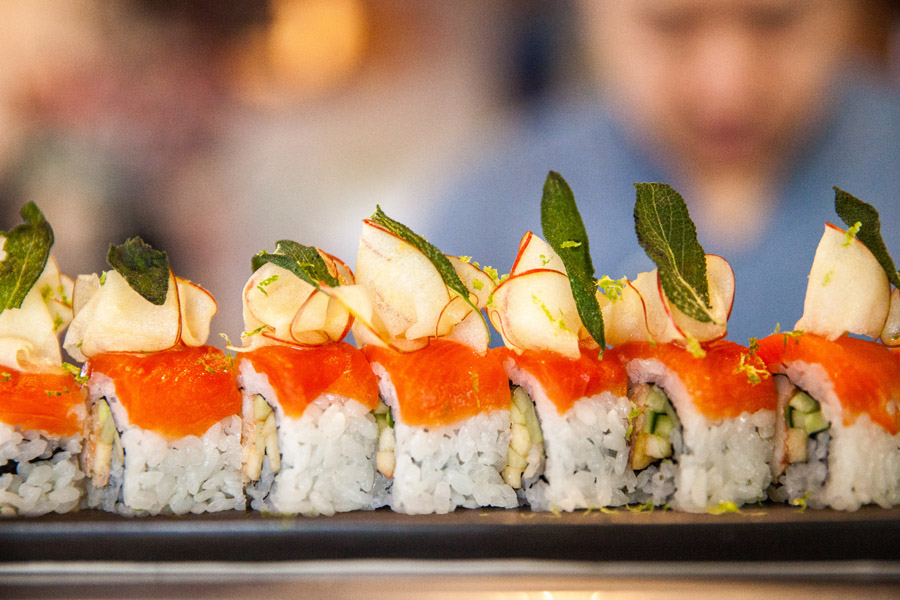 Bamboo Sushi occupies the space between kaiten-zushi and omakase sushi. This is the Kimono Roll.
Bamboo Sushi occupies the space between kaiten-zushi and omakase sushi. This is the Kimono Roll.
For a restaurant in the class of Bamboo Sushi, fortunes run somewhat opposite economic trends. The restaurant opened in 2008, right smack in the middle of the recession, and met with early success. Unable to afford luxuries, consumers paid for affordable meals out.
Ryan Roadhouse, one of Bamboo’s early chefs, says in those days the restaurant lay at the upper end of the sushi spectrum. Kaiten-zushi, the low-end conveyor belt variety, dominated the Portland market.
Today, with deeper pockets, consumers can turn to other restaurants or entertainment options. Adding to the competition, Roadhouse says, the Portland sushi market has diversified to include higher-end experiences. The former Bamboo chef spun off his own Southeast omakase project, Nodoguro, and he’s seen an uptick in such “chef’s choice” models.
“At one point, when checks reached around the $100 mark, that would be kind of pushing it,” Roadhouse says. “Maybe demographics are changing, more diners are looking for that.”
Bamboo occupies an unusual liminal space between sushi train and omakase. It thrives off high volume: lots of customers, lots of sushi choices. To grow, it needs to attract large numbers of customers in an increasingly competitive market.
“You can’t get lazy or complacent at all,” Lofgren says. “You have to stay focused on your success.”
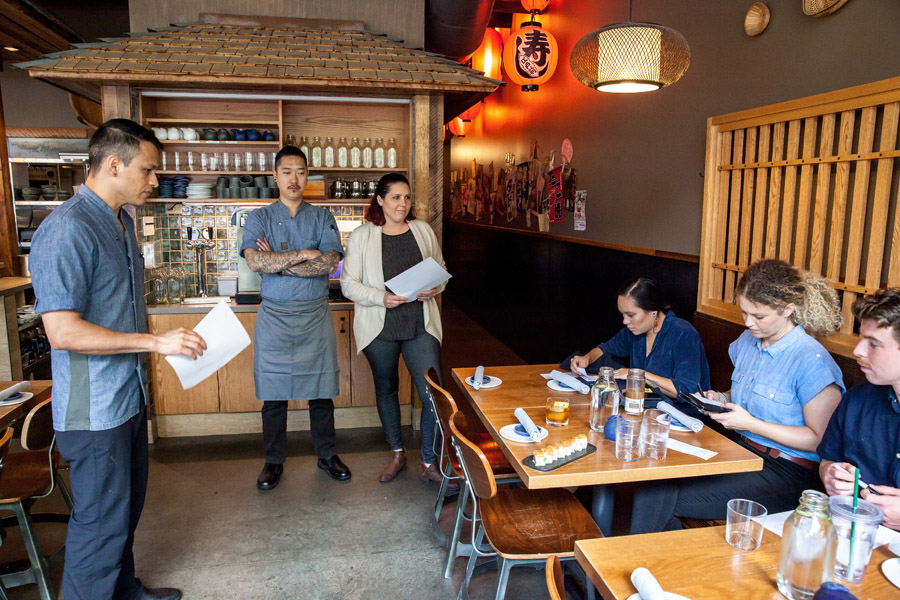
Manager Amy Campbell (center) leads a team meeting at the downtown Bamboo Sushi.
As consumers encounter more choice, so do workers. Today’s tight labor market pressures restaurants to step up pay and benefits to retain career employees, straining the notoriously tight margins of restaurateurs.
“The restaurant environment is kind of a tale of two cities right now,” says Warren Valdmanis, one of the founding investors with Bain’s Double Impact Fund. “The economy is doing well, so there’s decent demand; on the other hand, it’s difficult to attract and retain workers.”
Portland’s rising transportation and housing costs add to workforce challenges, Weaver says. “It’s hard to attract employees when people can no longer afford to live in the city and commutes have become a hardship.”
Lofgren says the gig economy compounds the problem, encouraging freelancing over the traditional daily grind. Young people choose to be Uber drivers rather than cooks or dishwashers, where the eight-hour day is a minimum and some shifts top out at 14 hours.
“You’re not getting as many career servers, hosts, even general managers,” Lofgren says. “There’s a massive difference between somebody who’s been in the restaurant industry for a year and somebody who’s been in it for 10 years plus.”
The most elusive employees are those like Bamboo’s chef Jin Soo Yang, one of a dwindling cadre of elite sushi chefs. His colleagues are in such high demand, Soo Yang says, that they often live nomadically, rotating through the major metro markets as they please. Soo Yang bucked this trend and stayed at Bamboo for eight years. He says the benefits, people and mission-driven approach keep him around.
 Bamboo Sushi chef Jin Soo Yang at the Portland Japanese Garden
Bamboo Sushi chef Jin Soo Yang at the Portland Japanese Garden
Valdmanis calls Bamboo Sushi’s attractive work culture a “strategic advantage.” It reduces turnover and improves customer experience. Line cooks with zero experience start at $15 an hour. Tiffany Peña, a bartender at Bamboo Sushi with 15 years of restaurant experience, says she makes $12.50 an hour, plus tips that add up to around $35 hourly. Employees get health insurance and 40 hours of paid time off annually.
“It’s the first time I’ve ever had that,” Peña says. “I’ve even held management positions where they didn’t have those benefits.”
Those perks, however, don’t come cheap. Keeping pace with rising wages and the tightening labor market could prove difficult as Sustainable Restaurant Group expands.
“Every restaurant type has its own challenges,” Lofgren says. “In fast food, labor is lower cost, but it’s hard to find people who care. We find a lot of people who really love what they do, but they’re expensive.”
Unlike in other industries, automation is not a viable cost-cutting solution. In fact, it runs counter to the very nature of the restaurant business. People want to buy food cooked and served by other people.
“You want to see the chef, you want to watch the person, you want to hear about somebody’s mom’s recipe that they passed down,” Lofgren says. “There’s something very human about restaurants.”
For the first seven years of Bamboo Sushi’s existence, Lofgren left a cornerstone ingredient, octopus, off the menu. That’s because most fishermen snare octopus by dredging coral reefs. The process pulverizes living coral that takes millennia to grow. It’s like finding a needle in a haystack by burning all of the hay.
At last Lofgren found suppliers who dive for octopus or, in a method called “bycatch,” wait for the prey to swim into crab traps.
Lofgren founded Bamboo Sushi to make a difference for the environment. But he also found the mission contributed to his bottom line. He reorganized his supply chain for maximum efficiency and capitalized on a “social mega-trend,” as Valdmanis puts it: “the conviction that Americans are going to eat more healthy, sustainable food in the future than they do today.”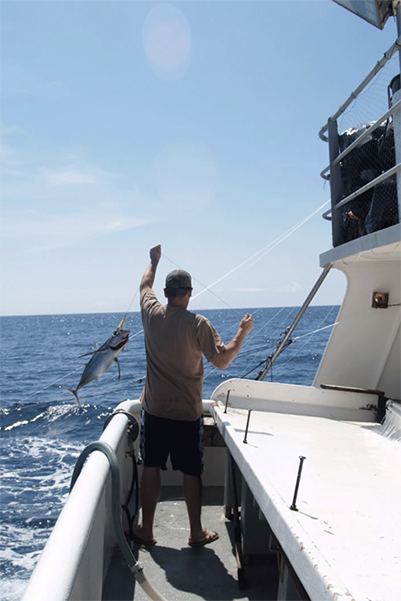
PHOTO:Line-caught fish
A wave of plant-based wins backs that claim: A vegan nut-milk company won PitchfestNW this year, and Bend-based veggie-burger chain Next Level Burger opened locations nationwide. Sustainability, veggie-centric cuisine, food-waste reduction and local meat and seafood sourcing all numbered among the National Restaurant Association’s top 10 industry trends for 2018.
When it comes to eating healthy, local, sustainable food, Valdmanis says, “we’re pretty convinced that this is going to be a durable trend.”
Plant-based protein stars in that movement, but Kipp Baratoff, co-founder and vice president of Fishpeople, a Portland-based sustainable seafood retailer, says seafood is poised for an outsize role. “When you look at the protein per fat on a per-gram basis,” Baratoff says, “fish, pardon the pun, blows beef and other land-based protein out of the water.”
“If you study business and you look at the businesses that outperform other businesses, oftentimes they are swimming upstream.”
— Kristofor Lofgren
Beside every choice of fish on the QuickFish menu, customers find the method of catch. These time-consuming fishing techniques—deep-set longline, purse seine, gillnet—add between 10% and 30% on average to the cost of ingredients, Lofgren says.
Through reworking the traditional restaurant supply chain, however, he’s slashing that premium. Usually, a restaurant phones its supplier to renegotiate every time it changes the menu. Lofgren commits to leaving staples, like salmon, on the menu for years. When suppliers land a long-term contract, they often agree to drop their price.
Lofgren’s supply-chain ambitions reach far beyond his own business. He seeks to reorganize global seafood distribution around sustainable fishing and aquaculture. Most fish of the future, Lofgren says, will not be caught but farmed. The World Bank agrees, declaring that aquaculture will furnish most of the world’s seafood by 2030.
Baratoff appears less bullish on aquaculture, reinforcing the role of wild-caught fish. The future of fish leans to some degree on aquaculture, he says, but the economic vitality of coastal communities depends on fishing. It always will.
“Our coastal ecosystems and communities can’t survive or thrive without healthy, plentiful fish in the ocean and well-managed fisheries,” Baratoff says. “Not every stretch of the coast can be a tourist town.”
The need for sustainable farming and fishing grows more urgent by the day, Lofgren says, as global population swells. “If we can manage our resources efficiently and create the most efficient supply chains possible and the most efficient forms of feed, we can feed these people. If we do it the same way we’re doing it today, absolutely not.”
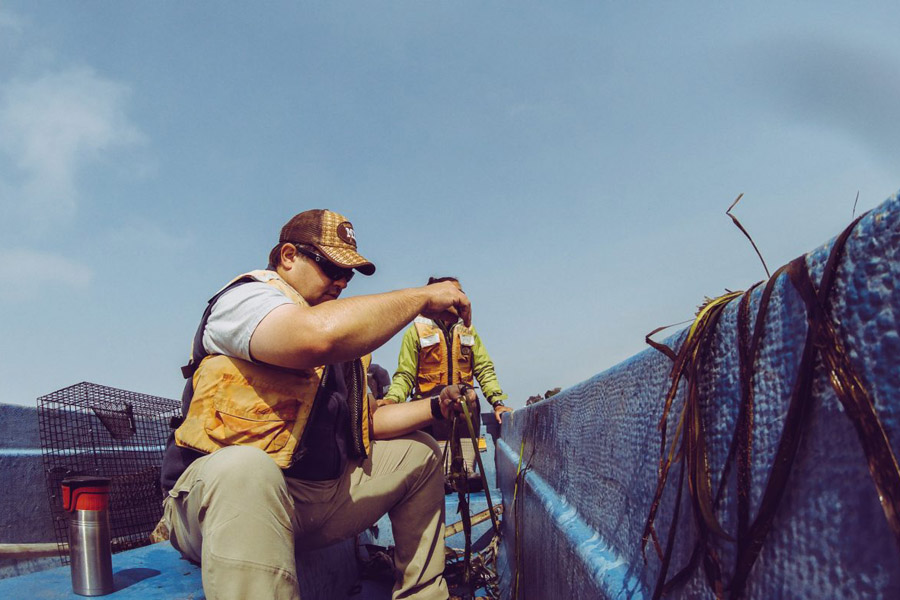
Planting sea grasses
As Sustainable Restaurant Group expands, propelled by the Bain Capital Double Impact Fund, Lofgren will have to maintain his sustainability focus at a larger scale. While the sustainability trend undoubtedly holds fast nationwide, it’s perhaps less of a rage outside hippie Portland.
“In Portland, right off the bat more people care about that,” Roadhouse says. “But in other markets you have to gauge how important that is to diners.”
The company’s recent equity investment also raises questions about whether Lofgren can keep the company focused on sustainability and social good along with profit. Critics of private equity say investors value cost-cutting over saving the planet or creating living-wage jobs.
A disclosure required of private companies when they raise capital, called a form D, filed with the Securities and Exchange Commission listed Valdmanis and Lofgren as people related to an investment reported as equity, with $8.5 million sold of a total offering of $15 million. Representatives from the Double Impact Fund joined Lofgren on Sustainable Restaurant Group’s board.
As the changes take effect, Lofgren feels confident he can preserve the fundamental tenets of Bamboo Sushi. The Double Impact Fund, he notes, operates on its own bylaws, independent of Bain Capital. The fund boasts a track record of growing earth-friendly eateries, including vegan fast-casual restaurant By Chloe.
The investments are rooted in the trend of impact investing. Some venture capitalists are theorizing that companies with an environmental or social mission breed creativity and innovation. They also can prove more resilient during an economic downturn.
“Bain Capital in a general sense is probably not a mission-aligned partner,” Lofgren says. Yet he says that within the Double Impact Fund, “all of the businesses that are going to be invested in are very similar to ours. As we take on capital to grow, we will focus on partners that are aligned from a mission standpoint.”
While the Japanese Garden gathering maintained a casual tone, Lofgren infused an undercurrent of activism. When the time comes, he hopes city and business leaders will throw their weight behind sustainable causes.
While social and environmental responsibility now seem expected of many business leaders, in Bamboo Sushi’s early days, Lofgren had trouble selling that notion.
“At the beginning, it was much harder because you didn’t have a lot of people who believed in what we were doing. They were just focused on money,” he says. “But in fact, if you study business and you look at the businesses that outperform other businesses, oftentimes they are swimming upstream.”
The question remains whether Lofgren can keep his commitment to sustainable practices as costs and competition rise and his company encounters new markets.
Yet a sea change favors sustainable concepts like Bamboo Sushi and QuickFish. The B-corp revolution, impact investing and a renewed emphasis on sustainability have reshaped the business environment. The work of active B-corporations, notably Patagonia and other outdoor-gear companies, now features in the national public-policy conversation. Across many sectors, Lofgren and other business leaders have taken more active roles in environmental protection, as federal policies go the other way.
“I think the business leaders are more important than politicians,” Lofgren says. “The government has clearly shown itself not to be willing to act. As the years go by, we just have more and more roadblocks, more and more people just protecting their power instead of working for the good of the people. The one good thing we have is capitalism.”
Aquaculture Adrift
Kampachi Farms, an aquaculture project in Kona, Hawaii, typifies the model Lofgren would like to see replicated nationwide. Lofgren recalled swimming with the fish, which feed on a natural diet, in an open ocean swell.
Most fish farms in the United States, however, get it wrong, Lofgren says. Open aquaculture, in which only a net or cage separates farmed fish from their natural surroundings, leads to “free exchange of disease, parasites and fecal matter,” an article in Aquaculture Methods states.
A 2012 study from the Center for Food Safety found that 25 million fish escaped from farms. In one case close to home, last summer a salmon pen in the San Juan Islands released thousands of non-native fish into the northern inland waters, wreaking havoc on the delicate ecosystem.
Ironically, Lofgren says, stringent government regulations designed to promote sustainable aquaculture limit its viability. Other obstacles, Baratoff says, include a lack of consumer demand, a dearth of science-based management strategies and environmental factors.
The strength of fisheries that export salmon and other high-end products weakens the return on investment for farming. U.S. consumers, he says, eat mostly finfish and shrimp, which thrive in environmental conditions outside the United States.
Consequently, the practice has advanced in other developed countries while its domestic development lags. The annual average growth rate in aquaculture between 2003 and 2005 in North America and Europe hung around 1.4%–1.6% while it boomed in China, Asia and South America (6%, 11.2%, 7.8% respectively).
“They have our technology, and they’re farming fish faster and better than we are,” Lofgren says. “We should be the leaders in aquaculture.”
This article has been edited with the following correction: Castagna is still open. Cafe Castagna, a different restaurant, closed and reopened under a different name.
To subscribe to Oregon Business, click here.


